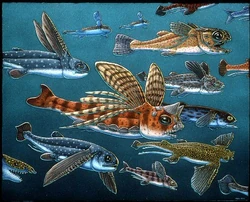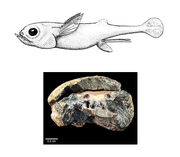| Iniopterygiformes Fossil range: Devonian - Carboniferous | |
|---|---|
 A group of Iniopterygians by paleo-artist Ray Troll | |
| Scientific classification
| |
|
Holocephali | |
|
Iniopterygiformes | |
| |
Iniopterygiformes (meaning "Nape Wing Forms") are an extinct order of sharks that lived from the Devonian to Carboniferous periods (345-280 million years ago). Fossils of them have been found in Montana, Indiana, Illinois, and Nebraska. The Iniopterygians are characterized by large pectoral fins, wing-like projections on their backs, mounted high on the body and denticulated bony plates on the head and jaws. Iniopterygian sharks were small, and their average length was about 1.5 feet (45 cm.). The elongated pectoral fins had denticles along the leading edge which may have had a role in mating. They are thought to have been able to move their pectorals in a vertical plane,”flying” through the water much like modern-day flying fish.
Iniopterygians are classified in the order Iniopterygiformes, which includes the family Sibyrhinchidae. Members of this family include Sibyrhinchus denisoni, Inioptera richardsoni, and Inioxyele. Iniopteryx rushlaui is an Iniopterygian shark species that has not yet been assigned to a specific family. The closest modern-day relatives of the Iniopterygii are the Chimaeras (Chimaeriformes) also known as ghost sharks or rat fish.
These fish had several unusual features: massive skulls with huge eye sockets, shark-like teeth in rows, tails with clubs, enormous pectoral fins that were dorsalized or placed almost on their backs, and bone-like spikes or hooks on the tips of their fins. Most iniopterygians were fairly small, averaging about 6 inches to 1.5 feet (45 cm.) in length, with the largest approaching sizes of 50 centimeters (20 inches) at most.
Brain case discovery[]
- "Fossilized brains are unusual, and this is by far the oldest known example."
- —John Maisey, Curator in the Division of Paleontology at the AMNH.

Artist's rendition of the Iniopterygian, and the fossilized braincase.

Fossil Brain in 3-D
A 3-D scan revealing the oldest known fossil brain.
green = braincase
red = endocranial cavity
orange = brain
In March of 2009, digital x-ray images of a 300 million-year-old Iniopterygian from Kansas, Sibyrhynchus denisoni, revealed the oldest known fossilized brain. Alan Pradel of the Museum National d’Histoire Naturelle in Paris and his colleagues recently scanned the brain.
The scans revealed the fish had a pea-size brain, measuring 1.5 millimeters by seven millimeters (0.06 by 0.27 of an inch), much smaller than the braincase itself. This is similar to modern sharks, rays, and chimaera fish, whose brain growth slows as they age, even as the rest of their bodies expand.
The Iniopterygian's brain shares several features with living ratfishes, which means that these skull features have been conserved in the group for the last 300 million years. Complete reconstructions of these skulls were made with a CAT scan and X-ray synchrotron microtomography, and the imaging of one skull showed a dense, symmetrical object sitting within the large braincase, revealing that this was a mineralized brain.
Further analysis of the fossil indicated that the area where the brain-like structure reaches the surface of the sample reveals a high concentration of calcium phosphate, whereas the surrounding matrix is almost pure calcium carbonate. The mineralization of the brain is, according to the main author of the paper, Alan Pradel, from the MNHN, "due to the presence of bacteria that covered the brain shortly before decay and induced its phosphatization".[1]
The Iniopterygian's brain has a large lobe for vision, and the skull has relatively large eye sockets. This suggests the fish was using its eyes as a major way to locate prey. The auditory section of the brain is reduced, and this information reflects observations of the inner ear in iniopterygians. In addition, the hearing-related section of the brain is flattened. This reflects the curious arrangement of the Iniopterygian ear, which was optimized for side-to-side movement, but not up and down movement.
References[]
- ^ European Synchrotron Radiation Facility (2009, March 3). First Fossil Brain: Shark Relative That Lived 300 Million Years Ago Yields Very Rare Specimen. ScienceDaily. Retrieved March 5, 2009, from http://www.sciencedaily.com /releases/2009/03/090302183128.htm